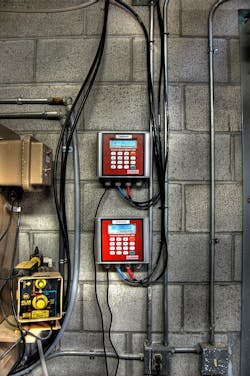Ultrasonic Flowmeter Improves Water-Loss Calculations
In 2008, after experiencing two years of drought and the driest spring in recorded history, water reserves in California were desperately low.
Carmel Riviera, which serves up to 600 residents living along California’s Big Sur Coast, made the choice to upgrade to high-performance flow measurement instrumentation to understand exactly where water was going.
“This was an important step to drive water conservation by understanding our water-loss percentage, improving production efficiency and water quality by reducing backflush, and more accurately identifying over users,” said Wayne Daniel, head of operations.
Like most independent water companies, Carmel Riviera contracts the operation of its production facilities to a third-party expert. Carmel Riviera draws water from eight operational wells and the nearby Mal Paso Creek and has long relied on the expertise of Carmel Lahaina Utility Services Inc. of Carmel Valley, Calif., to assure that their drinking water is always clean and available.
With its ozonation system, using ozone as an oxidant in the treatment process, SCADA operating system, Carmel Riviera Mutual Water Co. is on the cutting edge of water treatment for an independent, grade 2 water company.
The company had always suspected that non-revenue water-loss in the distribution system could be up to 100,000 gal per month. It decided it was time to finally discover how much water was really missing. For years, the company relied on water readings taken from antiquated, worn-out mechanical paddle-wheel flowmeters.
Implementing Solutions
In fall 2008, the company upgraded its water treatment plant with three of Sierra’s Innova-Sonic Model 205 transit-time ultrasonic flowmeters.
The company appreciates the versatility of Sierra’s meters with their ability to clamp on to any size pipe. Flowmeters are made from a variety of materials, from galvanized steel and cast iron pipes to PVC.
“Two pipe clamps and you’re done,” said Eric Furtado, the lead water operator from Carmel Lahaina. “It’s a much less invasive installation. You can detach the readout from the cable, move anything anywhere you want to move it. You can unplug them and you won’t lose all your data. With Sierra, the sensor is external to the pipe; regardless of what’s running through the pipe, it’s not going to affect our ability to read what’s in the pipe.”
An ultrasonic signal is transmitted in the direction of the flowing fluid (downstream), and then another signal is transmitted against the flowing fluid (upstream). The time for the sonic pulse to travel downstream is compared to the time for the pulse to travel upstream. This differential time is then used to calculate the velocity of the flowing fluid.
Flowmeters allow operators to test signal strength and quickly verify that the meter is indeed working, a welcome change to breaking pipes.
With the flowmeter upgrade complete, water readings were finally trusted. The company discovered mystery water loss almost immediately. In the filtration stage of water treatment, raw water is pumped through a 4-in. pipe and filtered through a garnet-red sand media that captures any particles that are not water soluble.
When these particles on the red sand media begin to build up and clog the system, the pressure outside the inlet valve increases, triggering a backwash cycle. This is a reversal of flow that lifts the red sand media and cleans the particles that have built up over time.
During a routine check of the meter readings during a backwash cycle, the company noticed that both the backwash meter and the production meter were registering.
In fact, they were not only recording false water production, but 500 gal of backwash water was entering the finished water supply. This also verified that each backwash cycle uses about 4,500 gal of water.
Cost-Effective Results
The company's water management system now provides accurate and precise water production readings to accurately calculate water loss rates.
Through better water measurement, the company discovered it was overestimating its water loss by 18%. As a result, it significantly reduced the annual $60,000 maintenance and operations budget, shifting excess funding to improve conservation and efficiency to generate more water to sell to customers.
The company estimated its annual water loss rate through leaks, waste, evaporation and other losses at around 30% of the total produced. The company budgeted almost $60,000 per year in initiatives to reduce these leaks, including labor and materials for surveys and expensive repairs.
After six months of using the flowmeter, the company found their actual loss rate to be only 12% of production. The improved production and usage figures derived from the flowmeter enabled the company to significantly reduce its annual maintenance and operations budget to target more funding on improving conservation and efficiency.
Scott Rouse is product line director for Sierra Instruments. Rouse can be reached at [email protected] or 831.373.0200.
